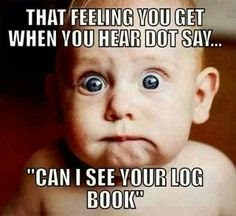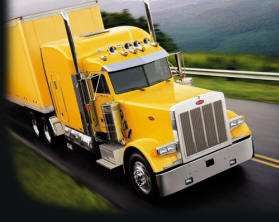A Couple Securement Questions For The Flatbedders On The Forum
Topic 5169 | Page 1

I may be wrong but it is my understanding that if you attach one end to the trailer and go through the securement point and then back down to the trailer (even on the same side) with the other end then you get the full WLL of the securement.
I now have a binder on each side of the same chain and there is still slack in the middle but its just useless excess chain. So my questions are this. Is it ok to put two binders on the same chain rather than having one binder per chain? The way I look at it, is by putting the two binders the chain is isolated and being pulled in each respective direction thus, to me, making it a direct tie down on each side and halving the WLL. Is that correct? Is this a normal practice? or should you use 1 binder per chain?
You are correct. I do this all the time to save dragging out an unnecessary chain. You are also correct that each side is only 1/2 the WLL of the securement. The thing is with equipment, you need that securement tight and sometimes putting one binder in the middle will not work as well as one on each side. If you were to say run the chain from one side of the trailer through the eyes and then to the other side of the trailer, there is still nothing keeping the load from sliding along that chain from side to side. Thus the need for securing it like you explained.
I did one the other day where I stretched the chain across the deck and through the securement points on the trailer and then took the hook up to the equipment and put a binder on each side only my slack was on the deck of the trailer. If you are uncomfortable about the slack then just put a bungee on the slack to hold it.
I think that the direct tie down is with one end of the chain hooked to the load and the other end to the trailer.
You are doing well learning this stuff on your own. I am impressed with what you have shown so far.

Have you looked into Cypress truck lines or CT transportation? I'm pretty sure both are based out of Florida. They will get you home on the weekends too. Also look at McElroy, I'm not sure if they operate in your neck of the woods or not, though.

I work for a construction company and haul equipment.we run chain from one side of the trailer thru the eye on the equipment to the other side of the trailer.use a binder on one side to tighten the chain and wrap the extra chain around and under the tightened chain.the replies here make me wonder if this is considered "correct".and what does wll mean?thanks

I work for a construction company and haul equipment.we run chain from one side of the trailer thru the eye on the equipment to the other side of the trailer.use a binder on one side to tighten the chain and wrap the extra chain around and under the tightened chain.the replies here make me wonder if this is considered "correct".and what does wll mean?thanks
Is fine to do. WLL is Working Load Limit. It should be stamped on the chain and binders as well as the hooks for the chain. You need the WLL to be at least 1/2 of the total weight of the equipment that you are hauling. If you are hauling a piece of equipment that weighs 40,000 pounds you better have a total of 20,000 WLL on your securement. That is adding up all the chains together. So if you are using 3/8 inch chain and binders you would need 4 chains. The problem comes when you tie to the securement point with one end of the chain and then the trailer with the other. That cuts your WLL in half so a 6,600 lb WLL 3/8" chain is now only 3,300 pounds. This is the basics as there are also other factors that come into play.

...sucks when you don't even understand the question.

LOL.
-mountain girl

Thanks pat!great answer.i'm gonna have to do some research.

Well let me give you a couple of examples with 2 different pieces of equipment. It is what you are securing that determines how you secure it.
First one is a lube truck. Not sure but probably a 2 ton truck. With this one, on the rear of the truck I secured by running the chain over the frame section and secured pulling forward. I am not worried about the truck moving side to side along the chain as it is a pretty stable platform.
Second one is a street sweeper. It has a securement point on each corner. Because of the way the rear securement is constructed I attach one end of the chain to the securement point and the other end to the trailer. On the front I run the chain flat across the deck, through the securement points on the trailer and then the hooks go up to the securement points on the sweeper. Now I could have run it through the points on the sweeper and the hook ends to the trailer and used one binder but this particular piece only had a single tire in the center kinda like a golf cart. So I used a binder on each side to keep the sweeper from tipping on a corner.
Here is another to think about....

This is 50 feet long and weighs less than 10k. With that, one chain would suffice to secure it because of the WLL rating of the chain BUT,,,, there is always something more to deal with. Remember, you need securement every 10 feet of length. So with 5 chains on this baby, you were not going to budge this one.

When in doubt always consult the FMCSA.
http://www.fmcsa.dot.gov/regulations/cargo-securement/cargo-securement-rules
When an article of cargo is not blocked or positioned to prevent movement in the forward direction, the number of tiedowns needed depends on the length and weight of the articles. There must be - one tiedown for articles 5 ft or less in length, and 1,100 lbs or less in weight; two tiedowns if the article is -
1. 5 ft or less in length and more than 1,100 lbs in weight; or 2. greater than 5 ft but less than 10 ft, regardless of weight."
And
"secure an article or group of articles against movement must be at least one-half the weight of the article or group of articles. The aggregate working load limit is the sum of: One-half the working load limit of each tiedown that goes from an anchor point on the vehicle to an attachment point on an article of cargo; and The working load limit for each tiedown that goes from an anchor point on the vehicle, through, over or around the cargo and then attaches to another anchor point on the vehicle."
Phil
CSA:
Compliance, Safety, Accountability (CSA)
The CSA is a Federal Motor Carrier Safety Administration (FMCSA) initiative to improve large truck and bus safety and ultimately reduce crashes, injuries, and fatalities that are related to commercial motor vehicle
FMCSA:
Federal Motor Carrier Safety Administration
The FMCSA was established within the Department of Transportation on January 1, 2000. Their primary mission is to prevent commercial motor vehicle-related fatalities and injuries.
What Does The FMCSA Do?
- Commercial Drivers' Licenses
- Data and Analysis
- Regulatory Compliance and Enforcement
- Research and Technology
- Safety Assistance
- Support and Information Sharing
DOT:
Department Of Transportation
A department of the federal executive branch responsible for the national highways and for railroad and airline safety. It also manages Amtrak, the national railroad system, and the Coast Guard.
State and Federal DOT Officers are responsible for commercial vehicle enforcement. "The truck police" you could call them.
Fm:
Dispatcher, Fleet Manager, Driver Manager
The primary person a driver communicates with at his/her company. A dispatcher can play many roles, depending on the company's structure. Dispatchers may assign freight, file requests for home time, relay messages between the driver and management, inform customer service of any delays, change appointment times, and report information to the load planners.
Oops meant o include:
For example, if you're hauling a 20,000-lb. backhoe-loader, you need chains that can support a minimum of 10,000 lbs. A 3/8-in. grade 70 chain has a rated capacity of 6,600 lbs. Because this would be divided by two according to the load limit calculation, you would need four 3/8-in. chains to properly secure the machine. If you're hauling a 40,000-lb. excavator, you would need to either add more chains or upgrade to 1/2-in. chain for greater capacity.
New Reply:
New! Check out our help videos for a better understanding of our forum features

















Preview:
This topic has the following tags:
Driver Responsibilities Flatbed Load Securement Photos Safe Driving Tips Understanding The Laws







 TT On Facebook
TT On Facebook
Whats up guys,
I've been "lurking" as you guys call it on here since April and I had a few questions I wanted to ask to I figured I'd finally make an account.
A little bit about me: I want to get into flatbed work and maybe eventually into a heavy-haul type of gig. Not sure though. The only thing I'm certain of is I want to do flatbed work. I am 24, originally from Queens, NY, and been in South Florida since 09 and I've been in the mortgage industry since i first came to Florida. Office work is not for me but in South Florida, office work is pretty much the only type of work where you will get paid decent money. As in not 10 or 11$ an hour. South Florida might also be the single worst place in the lower 48 to get hired on as a rookie driver for a flatbed company so I am planning on moving to Texas to an area just outside of Houston which will put me in a pretty good place I feel to get hired on somewhere. It's also where my wife's favorite sister moved to with her family so it will work out for both of us. I figure if i have to be OTR at least her family is nearby. Exxon is also moving their corporate offices to Houston very soon and will open up some 5-8k jobs which will hopefully work out for my wife as well. Consensus is that most rookie cdl holders will probably have to go OTR to get their start. There are the few exceptions I've seen on here but for the most part, it seems OTR is inevitable. Which is fine with me. I'm a go-getter and whatever it takes, I will do. Now with that being said I respect you OTR guys but I would much rather drive mon thru fri and have weekends home or maybe work my 14hr clock everyday but take my 10 hours at home or anything similar simply because i just rather sleep at home and see my wife everyday if even for 20 mins rather than sleep in the truck for weeks but with being off comes with the wheels not rolling which means no money and defeats the purpose at that point. So hopefully I can put my plan in motion. I'm shooting for moving to Texas in March of 2015 when my lease it up here in FL. Hopefully this time next year, i'll be behind the wheel!. Went on kind of a rant just now lol
Went on kind of a rant just now lol 
To my question which I direct at OldSchool, Pat M., Winetaster, and anyone else who might have knowledge on the subject of proper securement procedures:
My understanding is that a direct tie down means the chain goes from one side on the trailer, through the eye hole or whatever securement point there is and gets tied down back the the same side on the trailer with necessary binders, etc. Whereas, an In-direct is chain from one side, through the securement point and continuing through to the other side of the trailer where it is tied down. Assuming that is correct let me paint this picture and you guys tell me what you think.
A piece of equipment has two eye holes in the center front about 1.5-2ft above the deck. I take my chain, hook it to one side and run in through both eyes holes to the other side and hook it in respective stake pocket or to chain pocket or what have you. Now, in between the eye holes which are probably 1 ft apart, the chain is loose and hanging down. So I now take a binder and hook one end to the slack hanging in between the two eye holes and also hook a part of the chain down by where the chain itself is hooked into the stake pocket and I ratchet that tight. I repeat the process on the other side, with grabbing the remaining slack with one hook on the binder and grabbing a link down by where the chain is hooked in.
I now have a binder on each side of the same chain and there is still slack in the middle but its just useless excess chain. So my questions are this. Is it ok to put two binders on the same chain rather than having one binder per chain? The way I look at it, is by putting the two binders the chain is isolated and being pulled in each respective direction thus, to me, making it a direct tie down on each side and halving the WLL. Is that correct? Is this a normal practice? or should you use 1 binder per chain?
Also, will the DOT get ****ed for having loose chain laying on the middle of the deck even though it isn't long enough to comes of the sides or hit anything?
I know the books and reading materials might say one thing, but i've found that real life experience differs almost entirely of what you learn in the books on any subject really. Books give you the initial knowledge needed but hands-on real world "doing" get you the real knowledge and tricks of the the trade. So yea i was just wondering what you guys though. I appreciate any insight you can give. Thanks
CDL:
Commercial Driver's License (CDL)
A CDL is required to drive any of the following vehicles:
OTR:
Over The Road
OTR driving normally means you'll be hauling freight to various customers throughout your company's hauling region. It often entails being gone from home for two to three weeks at a time.
DOT:
Department Of Transportation
A department of the federal executive branch responsible for the national highways and for railroad and airline safety. It also manages Amtrak, the national railroad system, and the Coast Guard.
State and Federal DOT Officers are responsible for commercial vehicle enforcement. "The truck police" you could call them.
OOS:
When a violation by either a driver or company is confirmed, an out-of-service order removes either the driver or the vehicle from the roadway until the violation is corrected.